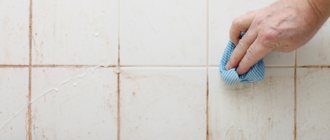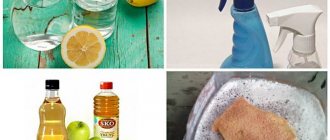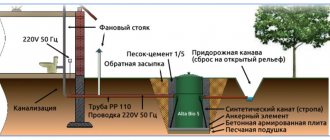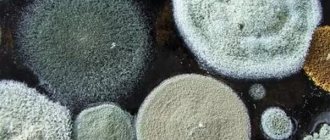The silicone sticks tightly to the tiles and it seems that nothing can clean it off.
The problem will be solved if you approach it wisely, having studied in advance all possible ways to remove sealant from tiles in the bathroom.
Features of using silicone sealant
Silicone sealant is a material characterized by plasticity and the ability to polymerize. When exposed to oxygen, it turns from a viscous paste into a strong but elastic mass. In addition, this material is able to firmly adhere to any surface. These properties allow silicone to be used to fill even small gaps.
After hardening, the composition reliably protects the holes from moisture penetration into them. Once cured, a secure bond is created that allows the material to function but prevents it from being removed. To choose the best method for removing a sealant, you need to consider its type: neutral or acidic.
Both have their advantages and disadvantages. Acidic varieties of the material include silicone and vinegar, so when they harden they emit a characteristic odor.
The advantages of this material include:
- fast curing speed;
- low cost;
- high adhesion.
At the same time, such compositions do not combine well with cement coatings, metals and natural stone. Due to the rapid hardening during work, stains of the substance should be immediately removed from the tile if they accidentally get on it. After they harden, this will be extremely difficult to do - only with the help of a solvent.
Neutral materials are made based on amines and alcohols. They are safer and more expensive. At the same time, the polymerization process of such compositions proceeds quite slowly, but after hardening it creates stronger adhesion.
It is almost impossible to wash it off after it hardens. Thus, mechanical action is often required to remove a layer of substance.
Specifics of silicone
Silicone sealant, or more simply silicone, is used in repair and construction work. It turns out to seal the seams, making them impenetrable to moisture, dust, etc. There is a need to apply a similar composition between the tile and any surface, for example a wall.
Applying sealant is not a difficult task - along the joint. The composition is poured directly into the seam. In the kitchen, it is convenient to use silicone to seal the joint between the wall and the kitchen apron, between the countertop and the sink, etc. Since the material is fluid, situations often arise when tiles or other surfaces are covered with sealant, which as a result affects the aesthetic qualities.
Note! In order to remove silicone sealant from tiles, the most important rule is to act quickly. Fresh dirt can be removed quickly, but with old dirt there may be complications.
Also, over time, it becomes necessary to replace the sealing seam, as it becomes unusable - it loses color, collapses, peels off in places, and begins to leak liquid. Therefore, you need to know how to clean the surface from it. Moreover, this must be done in such a way that a new one can be carefully applied.
The difficulty in removing the material lies in the fact that, due to its properties, it perfectly penetrates into materials, thereby adhering tightly to them. It is worth preparing for the fact that it will not be easy, especially if the tiles are porous, since silicone sealant penetrates especially deeply into such structures.
Before cleaning the surface, it would be a good idea to remember what type of sealant you are using; based on this, you can select an option for removing it from the tile.
Removing silicone with a knife
Ways to clean sealant from bathroom tiles
You can quickly remove any type of sealant only before it hardens. Some effort will be required once it has cured and adhered to the surface. Most of the composition can be removed mechanically. To prevent mechanical damage to the tiles, you should additionally use a chemical cleaning method.
Mechanical method
Most of the hardened silicone can be removed with a sharp knife designed for jointing.
In addition, during the work you will need the following tools:
- putty knife;
- eraser;
- blade;
- flat screwdriver;
- scraper;
- pumice.
First you need to take a knife and trim the sealant near the wall and the side of the bathtub. After this, using tweezers, you can remove the separated layer of the substance. This does not allow you to completely remove the sealing material, but you need to use other tools to remove any remaining silicone stuck to the surface.
In places where the sealant has filled the cracks, pry it up with tweezers and pull it out. In this case, the procedure should be carried out slowly so that the captured area does not accidentally rupture.
Mechanical removal of sealant requires care and precision.
Chemical method
Sealants soften when in contact with solvents, but it takes quite a long time to wash off the silicone. Chemical cleaning methods are used as additional ones: large volumes are difficult to eliminate. They are used after the main part of the substance has been eliminated mechanically.
Acid sealant is treated with compounds containing acid. To remove neutral silicone, you can use white spirit, gasoline, kerosene and acetone. To remove old substances from bathroom fixtures, it is recommended to use special flushing agents.
After removing the bulk of the silicone, the remaining part can be washed off with solvents.
Household chemicals
This is an easy way to clean tiles.
Chemicals are good at removing dried or old sealant. They are applicable on almost any surface except rubber or plastic.
It is important to choose the right substance that will be convenient to work with.
Alcohol
Alcohol-based silicone sealant is removed with technical or medical alcohol.
The substance acts on the sticky, viscous mass, softening and dissolving it. During the cleaning process, use a rag soaked in alcohol. It is used to wipe the area that needs to be cleaned.
Table vinegar
Acid sealant is created on the basis of concentrated acetic acid. Its presence in the composition can be easily determined by its characteristic pungent odor. Budget insulation products are created based on this substance.
They can be easily removed by moistening with vinegar essence (concentration of at least 70%). If necessary, repeat the procedure.
The work is carried out wearing protective gloves, windows and doors are opened wide.
White spirit, acetone
Solvents work well with quickly hardening substances.
White spirit and acetone dissolve expensive alcohol- or amine-based sealants. They are also called neutral. Such substances do not damage surfaces of any type and can be easily cleaned from them.
Soak a cotton swab in the solvent and wipe the contaminated area with it. After the product has dried, the procedure is repeated.
This is done until the sealant softens and turns into a mushy mass. Now it can be easily removed with a kitchen sponge.
Refined gasoline
This is an easy, budget-friendly way to clean tiles. The substance acts on the principle of a solvent. It effectively copes with neutral composition and can also remove sanitary sealant.
Soak a small cloth or sponge in gasoline and wipe the contaminated area. If necessary, repeat the procedure.
When working with solvents, you can clean the surfaces with a spatula or a construction scraper. The remains of the softened mass are removed with a regular office eraser.
Removers
A special remover has been developed for each type of sealant, for example: Antisil, Penta-840, Dow Corning OS-2, JVR Refinish Silicon Stop.
The products are available in the form of a paste or aerosol. They effectively, quickly and without residue dissolve sealant and silicone, but are aggressive towards all types of surfaces and human skin.
They are sold in construction stores. It is better to purchase the cleaner together with a waterproofing agent, without relying on your own accuracy and dexterity.
A universal means for removing sealant has not yet been invented. Combined methods are used to clean tiles. This is the most effective way.
The remover or solvent is applied liberally to the seam covered with sealant. Depending on the composition of the substance, the cleansing process will take from 1 to 8 hours.
As soon as the adhesive mass softens and becomes pliable, it is removed with any scraper. After work, wipe off the residue with a cloth soaked in warm soapy water.
How to clean without damaging the surface
To avoid damaging the tile surface when removing hardened sealant, you should cover the area above the treated area with masking tape. When carrying out mechanical cleaning, it is necessary to avoid applying too much pressure on the tile with a sharp knife. You can wipe off the remaining substances in hard-to-reach places and on the surface using a knife or blade.
The procedure must be carried out as carefully as possible: this will help avoid scratches.
If silicone does not respond, it is best to treat the contaminated area with a chemical solvent and wait a while. This will slightly increase the cleaning time, but will also help protect the surface from damage.
Tools to help
Often you have to use a mechanical method, that is, clean, tear off, scrape. But you need to act carefully with this so as not to damage the tile together with the silicone. It is best not to use this method in open areas, as scratches and some abrasions on the glossy surface will be very noticeable.
So, you will need:
- Knife.
- A piece of pumice.
- Metal scraper.
You need to be extremely careful when handling these tools. To begin, remove large layers of silicone; you should use a knife to do this. They can be used to carefully cut the material, layer by layer. Further, when the layer has decreased significantly, you can remove the remains with a pumice stone or a metal scraper.
It may happen that after applying silicone, yellowish stains will remain on the surface of the tile, especially in light shades; they can be washed with dishwashing detergent and a soft sponge.
Even after using special tools, excess silicone sometimes remains
Removing acrylic sealant
Acrylic sealants are both water-soluble and moisture-resistant. These compounds are used not for sealing, but for gluing. After hardening, they form a porous structure.
First, most of the sealant should be removed with a sharp knife or blade. After this, you need to treat the stuck residues with white spirit or acetone. After about 30 minutes, remove the softened particles of sealant with a wooden scraper. When using acrylic sealants, no greasy stains remain on the surface, so deep cleaning using detergents is not required.
Replacing sealant
After cleaning the seams, you can begin replacing the sealant. First, you need to apply masking tape to the tiles to avoid getting the product on areas that do not require treatment.
If you plan to seal the joints between the sides of the bathtub and the walls covered with tiles, it is better to use compositions that include a biocide. This substance will prevent the formation of fungus.
First, the surface should be degreased and dried. You need to prepare a tube of sealant according to the instructions. The product is carefully applied to the surface, and then a seam is formed. You need to remove excess sealant with a putty knife or an old plastic card. After 12 hours, you should also remove the masking tape.
To replace the sealant, place masking tape on the tile and carefully process the seam.
Unconventional solutions
It will help remove frozen silicone - dichlorvos. It needs to be sprayed onto the contaminated area and left for a few minutes. During this period, the silicone will soften and be easy to remove. Dichlorvos works thanks to the solvent that is in its composition - this is the solvent that has already been mentioned.
But you need to act very carefully with this composition, since inhaling the vapors is dangerous to health and life. This product can only be used in well-ventilated areas.
Effective and safe abrasive
Cleaning Precautions
When removing old silicone, be sure to wear gloves and safety glasses. Most solvents are flammable, so you should absolutely not carry out processing near open flames or heating devices.
After using chemicals, be sure to wash your hands thoroughly. When working with sharp tools, it is important to be careful to avoid cuts.
Be sure to wear gloves when working with solvents.
Tips and tricks from professionals
When using chemicals to remove silicone caulk, test on an inconspicuous area of tiles and fixtures. This will allow you to check the reaction of the surface to the substance used. It is advisable to cover with masking tape areas where chemical compounds are undesirable.
You should not try to pull out the frozen mass with a sharp movement. This can lead to damage to the tile joints. When planning to apply a new layer of silicone, you need to thoroughly dry the surface. Even if the material sticks to a wet surface, fungus will subsequently form underneath it.











